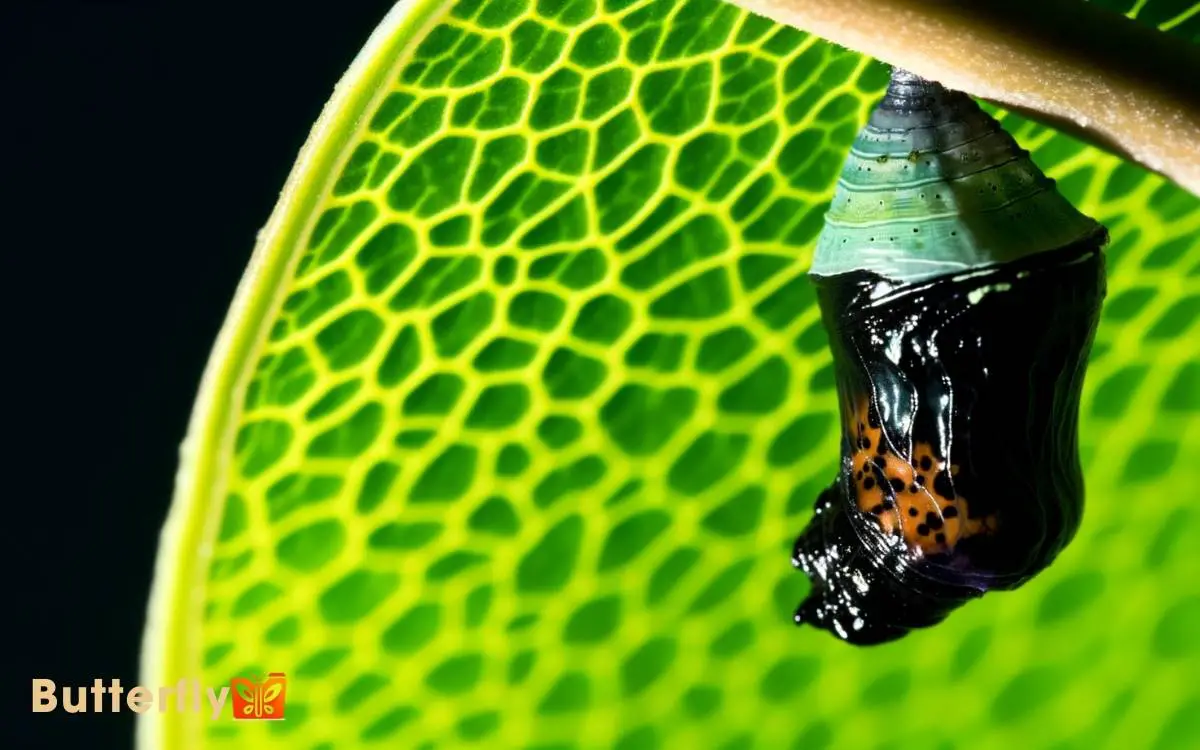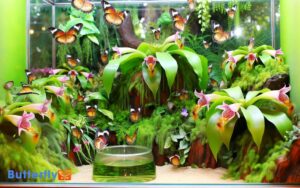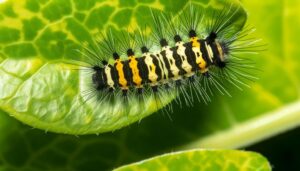Painted Lady Butterfly Chrysalis Turns Black: Explained!
A Painted Lady butterfly chrysalis turning black signals the final maturation phase of metamorphosis.
This color change reflects extensive biochemical and physiological processes, including melanin synthesis and exoskeleton hardening.
The black chrysalis indicates fully developed internal structures and readiness for eclosion, often within 24-48 hours. Seasonal factors such as temperature and humidity impact this transformation.
Carefully monitoring environmental conditions can guarantee a successful emergence. If they’re curious about all the intricate steps leading up to this pivotal moment, they’ll find the details fascinating.

Key Takeaways
Chrysalis Color Changes
Observing the Painted Lady butterfly chrysalis, one notes that its color changes are indicative of developmental stages and underlying physiological processes.
Initially, the chrysalis is a bright green, which signifies the early stages of pupation. As days progress, it gradually darkens to shades of brown and eventually black.
These shifts in coloration are caused by the hardening of the exoskeleton and the development of internal structures such as wings and antennae.
The blackening of the chrysalis, in particular, denotes the final maturation phase, where the butterfly’s wings are fully formed and pigmentation is complete.
This stage is pivotal for the butterfly’s successful emergence, as it indicates readiness for eclosion, the process of exiting the chrysalis.
Metamorphosis Explained
The darkening of the chrysalis marks the culmination of complex biochemical and physiological processes that constitute metamorphosis, transforming the caterpillar into an adult butterfly.
Within the chrysalis, enzymes break down the caterpillar’s tissues into a nutrient-rich soup. These nutrients are then reassembled into the structures of the adult butterfly, including wings, antennae, and reproductive organs.
Hormonal changes regulate these transformations, with ecdysteroids playing a pivotal role. The blackening indicates that the exoskeleton has hardened and pigmentation processes are nearly complete.
This color shift acts as a visual cue of imminent emergence. By the end of metamorphosis, the butterfly is fully formed and ready to break free from the chrysalis, completing its remarkable transformation from larva to adult.
Life Cycle Stages
A Painted Lady butterfly‘s life cycle consists of four distinct stages: egg, larva (caterpillar), pupa (chrysalis), and adult. Initially, the female lays tiny, greenish eggs on host plants. Within a few days, these eggs hatch into larvae, which are voracious feeders.
The caterpillars consume leaves, growing rapidly and undergoing several molts. After reaching full size, the caterpillar forms a pupa, or chrysalis, attaching itself to a secure surface.
Inside the chrysalis, remarkable metamorphosis occurs, transforming the caterpillar into a butterfly. This stage lasts about 7-10 days.
Upon completion, an adult butterfly emerges, expanding its wings and preparing for flight. The adult then seeks to reproduce, continuing the life cycle. Each stage is vital for the species‘ survival and propagation.
Formation of Chrysalis
The formation of the chrysalis in the Painted Lady butterfly involves distinct developmental stages, each marked by specific morphological changes. During this process, the caterpillar attaches itself to a surface and forms a J-shape before shedding its outer skin to reveal the chrysalis beneath. Inside the chrysalis, intricate transformations occur as the larval structures break down and reorganize into adult butterfly features. Eventually, the painted lady butterfly emergence takes place, revealing fully developed wings that need time to dry before the butterfly takes its first flight.
The initial green hue of the chrysalis gradually shifts to a darker color, indicating internal metamorphosis.
Environmental factors such as temperature and humidity greatly influence these color changes and the overall development process.
Chrysalis Development Stages
As the caterpillar prepares for metamorphosis, it initiates the formation of the chrysalis by secreting silk to anchor itself securely. Once anchored, the caterpillar undergoes a series of physiological changes, shedding its final larval skin.
The exposed chrysalis, also known as the pupal stage, features a hardened exoskeleton that provides protection during this vulnerable period.
During this stage, significant internal transformation occurs. Organs and tissues of the larval stage break down through a process called histolysis.
Simultaneously, histogenesis builds the adult structures from clusters of undifferentiated cells termed imaginal discs.
These discs differentiate into the butterfly’s wings, legs, and other body parts. Understanding these stages provides valuable insight into the intricate process of metamorphosis in the Painted Lady butterfly.
Color Changes Explained
Upon the completion of the chrysalis formation, noticeable color changes occur, marking the progression of metamorphosis in the Painted Lady butterfly.
Initially, the chrysalis appears green or light brown, providing camouflage against predators.
As metamorphosis advances, the chrysalis darkens, evolving to a brown or black hue. This color change signifies the imminent emergence of the butterfly, with the darkening caused by the development of the adult butterfly’s wings and body within the protective casing.
The darkened chrysalis provides a visual cue that metamorphosis is reaching its final stages. Observers can discern these changes as indicators of the underlying biological processes, reflecting the intricate and precise nature of lepidopteran development.
Environmental Influences
Environmental factors critically influence the formation of the Painted Lady butterfly’s chrysalis, dictating both the location and the structural integrity of this pivotal stage in metamorphosis.
Temperature, humidity, and light exposure all play significant roles. Ideal temperatures guarantee proper metabolic rates, while humidity levels prevent desiccation. Light exposure influences circadian rhythms, which can impact the timing of pupation.
Additionally, the presence of predators can compel larvae to select well-hidden sites, providing a safer environment for transformation.
| Environmental Factor | Influence on Chrysalis Formation |
|---|---|
| Temperature | Regulates metabolic processes |
| Humidity | Prevents desiccation |
| Light Exposure | Affects circadian rhythms |
| Predators | Influences site selection for safety |
Understanding these factors is essential for comprehending the complexities of chrysalis development in Painted Lady butterflies.
Coloration Process
The coloration process in a Painted Lady butterfly chrysalis involves intricate biochemical transformations that lead to the darkening of the exoskeleton. Initially, the chrysalis appears green, providing camouflage.
As metamorphosis proceeds, the epidermal cells synthesize melanin and other pigments, causing a gradual shift to darker hues. Enzymatic reactions, particularly the activity of tyrosinase, play a pivotal role in melanin production.
The darkening isn’t merely cosmetic; it signifies the strengthening of the exoskeleton, preparing it for the demands of emergence.
Observations reveal that the darkened chrysalis often exhibits patterns and speckles, indicating regions of concentrated pigment deposition.
This process reinforces structural integrity and safeguards against potential environmental stressors, facilitating successful maturation.
Pre-Emergence Indicators
Clear signs of an impending emergence in a Painted Lady butterfly chrysalis include the darkening of its exoskeleton and the visibility of the adult butterfly‘s wing patterns through the chrysalis casing.
As the metamorphosis progresses, the chrysalis’s transparency increases, revealing intricate details of the butterfly’s developing wings and body structures. The darkening exoskeleton, often taking on a blackish hue, signifies the final phases of development.
Observers will note the distinct outlines of wing veins and color patterns becoming more pronounced. Additionally, subtle movements within the chrysalis indicate that the butterfly is preparing for eclosion.
These pre-emergence indicators are critical for understanding the precise timing of the butterfly’s shift from chrysalis to adult, enabling better monitoring and anticipation of the event.
Black Chrysalis Significance
A black chrysalis in Painted Lady butterflies indicates the culmination of metamorphosis, marking the imminence of the butterfly’s emergence.
This final stage signifies that the pupal transformation is nearly complete. The darkening of the chrysalis is a critical observation point for entomologists and enthusiasts alike.
It reveals several key biological processes:
- Pigmentation Development: Indicates the formation of the butterfly’s wings and other structures.
- Tissue Reorganization: Reflects the extensive internal changes as larval tissues are replaced.
- Protective Mechanism: Helps camouflage the chrysalis from predators during this vulnerable phase.
- Emergence Timing: Signals that the butterfly will soon break free, usually within 24-48 hours.
These observations underscore the intricate complexity of Lepidoptera development and the precise timing necessary for successful metamorphosis.
Environmental Factors
Environmental factors play an essential role in the development and successful emergence of Painted Lady butterflies from their chrysalises. Temperature, humidity, and light exposure directly influence the metamorphosis process.
Ideal temperature ranges between 70-80°F, ensuring proper biochemical reactions. Inadequate humidity levels can lead to desiccation, impairing development inside the chrysalis. Conversely, excessive moisture may foster fungal growth, jeopardizing the pupa’s health.
Light exposure regulates circadian rhythms, impacting the timing of adult emergence. Additionally, air quality is important; pollutants can disrupt hormonal balances, affecting normal development.
A controlled environment mimicking natural conditions enhances the likelihood of successful eclosion.
Understanding these factors allows for better conservation and rearing practices, ensuring the Painted Lady’s life cycle proceeds without hindrance.
Common Concerns
One common concern among observers is the Painted Lady butterfly chrysalis turning black. This color change can be a natural part of the pupation process, indicating an imminent emergence.
Additionally, examining the chrysalis’s firmness and absence of foul odor can help determine its health.
Natural Color Change
When a Painted Lady butterfly chrysalis turns black, it often signals the imminent emergence of the adult butterfly, rather than indicating any underlying health issues.
This color change is a natural part of the metamorphic process. The darkening occurs as the butterfly’s wings and body develop and become visible through the semi-transparent chrysalis.
Key observations include:
- Pigmentation: The developing butterfly’s wings begin to show their characteristic colors.
- Transparency: The chrysalis becomes more translucent, revealing the butterfly’s form.
- Timing: The blackening typically occurs shortly before eclosion, the hatching stage.
- Temperature: Environmental conditions can influence the speed and intensity of this color change.
Understanding these changes demystifies the process and highlights the intricate beauty of butterfly metamorphosis.
Signs of Health
Careful observation of a Painted Lady butterfly chrysalis can reveal several key indicators of the developing insect’s health. A healthy chrysalis will exhibit a consistent, firm structure and maintain a uniform coloration until the natural darkening phase.
Any signs of deformation, excessive softness, or discoloration such as dark spots or mold suggest potential issues. Regular, rhythmic movements within the chrysalis indicate active development and vitality.
Additionally, the attachment to its substrate should be robust; a loose or detached chrysalis may hinder proper maturation. Observers should also note the timing of color changes; premature darkening can signal distress or disease.
Monitoring Development
As the chrysalis of the Painted Lady butterfly changes to a darker hue, researchers meticulously document each developmental stage to guarantee accurate data collection.
Observations of color changes and structural transformations are critical for understanding the maturation process. Researchers utilize high-resolution imaging and precise timing to capture each phase.
- Color shifts: Monitoring changes from green to black.
- Structural integrity: Evaluating the chrysalis’ firmness and texture.
- Behavioral cues: Noting any movements indicating nearing emergence.
- Environmental conditions: Recording temperature and humidity levels.
Detailed logs make sure that no subtle change goes unnoticed, allowing scientists to correlate physical transformations with underlying physiological developments.
Ensuring Healthy Emergence
To guarantee the healthy emergence of the Painted Lady butterfly, it’s essential to maintain ideal humidity levels between 60-70%. Consistently monitoring temperature within the range of 70-75°F will also support proper development.
These conditions promote successful eclosion and reduce the risk of deformities.
Maintain Ideal Humidity Levels
Maintaining ideal humidity levels around 60-70% is crucial for the healthy emergence of Painted Lady butterflies from their chrysalides.
Adequate humidity prevents desiccation and ensures that the chrysalides remain pliable, facilitating the butterfly’s escape. Insufficient humidity can lead to developmental issues and failure to emerge.
To achieve this:
- Use a hygrometer to monitor humidity levels within the containment area.
- Mist the enclosure lightly with water if levels fall below 60%.
- Include a moist sponge or damp paper towel inside the habitat to maintain moisture.
- Avoid over-saturation, which might encourage mold growth.
These steps create an environment conducive to the successful metamorphosis of Painted Lady butterflies, guaranteeing that they emerge strong and healthy.
Monitor Temperature Consistently
Monitoring temperature consistently is essential to guarantee the healthy emergence of Painted Lady butterflies from their chrysalides. Ideal temperatures range from 70°F to 80°F, promoting excellent metabolic rates and development.
Temperature fluctuations can disrupt the pupation process, causing deformities or failed emergences. Utilizing a reliable digital thermometer provides precise readings, ensuring temperature stability within enclosures.
Researchers and hobbyists should avoid placing chrysalides near direct sunlight or cold drafts, as these conditions can lead to thermal stress. Regular monitoring allows for timely adjustments, mitigating risks associated with temperature variances.
Documenting the temperature at consistent intervals provides valuable data, aiding in identifying potential issues. This meticulous approach ensures that the Painted Lady butterflies develop smoothly from chrysalis to adult form.
Post-Emergence Care
Once the Painted Lady butterfly emerges from its chrysalis, ensuring proper hydration and access to fresh nectar sources is crucial for its survival.
Post-emergence care involves several critical steps to support the butterfly’s health:
- Hydration: Provide a shallow dish with a sponge soaked in water to prevent drowning while allowing easy access to hydration.
- Nectar Sources: Place fresh flowers like lantana, zinnia, or butterfly bush within the butterfly’s environment to offer natural nectar.
- Artificial Nectar: Create a sugar solution (4:1 water to sugar ratio) and place it on cotton balls or sponges.
- Environment: Ensure the enclosure is spacious, well-ventilated, and free from potential hazards to allow for proper wing expansion and drying.
These measures will help maintain the butterfly’s vigor post-emergence.
Observational Tips
Careful observation of the Painted Lady butterfly‘s behavior and physical condition can provide valuable insights into its health and well-being.
- Monitor the chrysalis daily for any changes in color, indicating metamorphosis stages.
- A healthy chrysalis will gradually darken, signifying imminent emergence.
- Note any unusual discoloration, as this could suggest disease or parasitism.
- Temperature and humidity levels should be consistently checked, as deviations can affect developmental rates.
Observe the butterfly’s wings post-emergence; they should expand fully and symmetrically. Any crumpling or failure to expand warrants immediate investigation. Additionally, document feeding behavior; butterflies should actively seek nectar.
Conclusion
In an ironic twist of nature, the painted lady butterfly’s chrysalis darkens not as a sign of demise but as an indicator of impending life. This delicate stage, rife with scientific marvels, encapsulates the essence of metamorphosis.
Ironically, the very blackening that might suggest decay heralds the butterfly’s vibrant emergence. By closely monitoring these color changes, enthusiasts can guarantee a healthy transformation, preparing for the butterfly’s triumphant flight, which is anything but dark.






